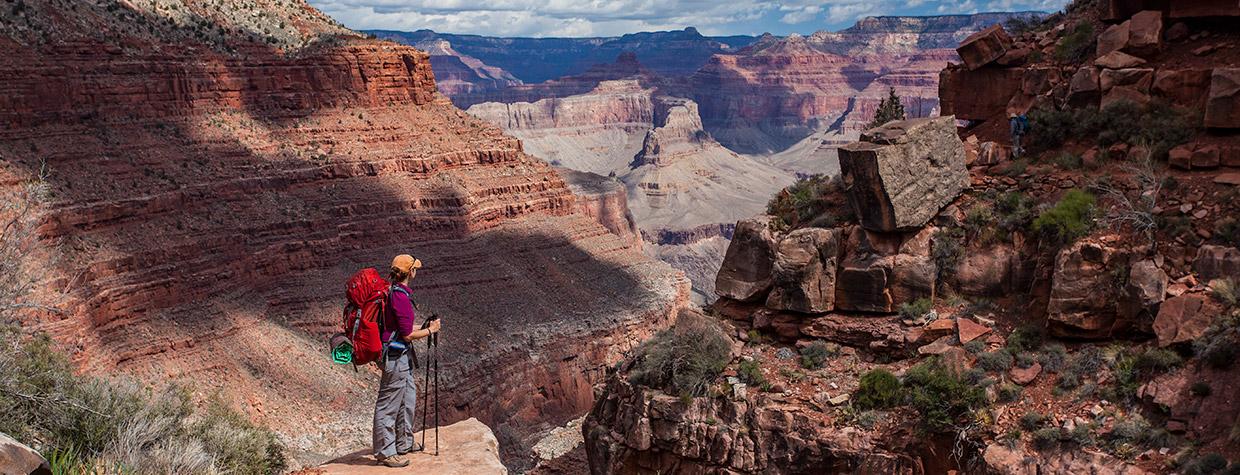Hermits Rest is the most distant stop on the Hermit Road, and it’s the place where hikers go when they’re looking for some quiet adventure. Ironically, that’s not why the Hermit Trail was built. It was built to move people, pork chops and bottles of Porto to Hermit Camp, a luxury campsite for tourists that predated Phantom Ranch by 10 years. In its heyday, the camp featured a tramway and a chef, among other amenities.
Although the camp shut down in 1930, the rim-to-river trail is still open. In all, it runs for 9.7 miles (one way) to Hermit Rapids, and while that number isn’t unheard-of for a day hike, the National Park Service strongly advises against going the distance in one shot. If you’re determined, know your limitations and touch base with the park’s backcountry office before you go. Otherwise, consider one of the trail’s segments, including the trek to Santa Maria Spring, as a day hike.
It’s a relatively short route — 4.4 miles round-trip — but distance in the Grand Canyon is exponentially greater than it is in other places. What’s more, the Hermit Trail doesn’t get as much maintenance as its world-renowned siblings (Bright Angel, North Kaibab and South Kaibab). Overall, it’s in pretty good shape, but there are places — most of them below Santa Maria Spring — where rockslides have covered parts of the trail. Also, because there isn’t a lot of foot traffic and rangers don’t make regular patrols, the rule about “never hiking alone” is especially important on the Hermit. Be mindful of the disclaimers, and you’ll have an incredible experience.
From the trailhead, which is a quarter-mile west of Hermits Rest, the trail immediately descends a break in the rim. The switchbacks are steep, and they’ll seem even steeper on the way out. Within five minutes, you’ll get your first good look at Hermit Basin and the Grand Canyon farther on. Geologically speaking, you’ll be dropping through what’s known as the Toroweap Formation, primarily limestone interbedded with siltstones and reddish sandstones. It’s something to think about as you make your way to the cobblestone switchbacks.
Once known as the “White Zig-Zags,” the cobblestones are a lasting reminder of the effort that was made to get tourists down to Hermit Camp. It came with a price, though. In 1912, when the trail was completed, tourists paid $18.25 ($572.20 in 2023) to be transported from El Tovar to the camp. Today, the experience is included in the price of park admission, but the cobblestones quickly disappear as you enter Hermit Basin and approach a junction with the Waldron Trail, which drops down from the Kaibab National Forest to the south. Just beyond the junction is a lush area of trees, grasses and flowers. The flora is fed by Sweetheart Spring, and the basin is a good place to see mule deer.
After 45 minutes of hiking, you’ll arrive at a second junction. This one leads to Dripping Springs (another good day-hike destination) and the Boucher Trail. The latter is named for Louis Boucher, who lived alone on the rim for 20 years and is considered the “hermit” of Hermit Basin. Stay right at the intersection and gear up for another series of switchbacks. This set, however, is more gradual than what you experienced up above. Within a few minutes, you’ll catch a glimpse of the Santa Maria Rest House. A few minutes later, you’ll arrive at the shelter, which was built in 1913. Water from Santa Maria Spring is collected in an old trough. It’s yours for the taking, but it must be filtered or treated.
Although Santa Maria Spring is the turnaround point for this listing, there’s a lot to see between the old rest house and the river below, including Lookout Point, Breezy Point, the Cathedral Stairs, Hermit Camp and the refreshing water of Hermit Creek. If you’re up for more, the long haul is worth the effort, but keep in mind, the route is remote and rugged, and you’ll need to take plenty of water and sunscreen, and hike with a friend. Louis Boucher hiked alone, but that was different. He was a hermit.
Trail guide
Length: 4.4 miles round-trip (to Santa Maria Spring)
Difficulty: Strenuous
Elevation: 6,640 to 4,880 feet (at Santa Maria Spring)
Trailhead GPS: N 36˚03.632', W 112˚12.742'
Directions: The trail begins a quarter-mile west of the Hermits Rest visitors center. From March 1 through November 30, the road to Hermits Rest is closed to private vehicles, and hikers must use the free shuttle bus that departs from near Bright Angel Lodge. Weather permitting, the road is open to private vehicles from December 1 through February 28.
Vehicle Requirements: None
Dogs Allowed: No
Horses Allowed: No
USGS Map: Grand Canyon
Information: Backcountry Information Center, Grand Canyon National Park, 928-638-7888 or nps.gov/grca

